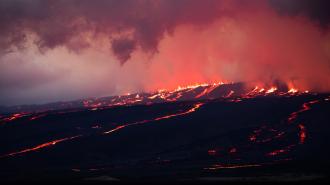Using a powerful supercomputer and an upgraded modeling program, researchers correctly forecast an impending volcanic eruption in Ecuador — five months before it occurred.
The challenge: A volcanic eruption can be devastating to those living nearby, so scientists often monitor active volcanoes for signs that they might erupt, such as increased seismic activity. Officials can then evacuate an area if an eruption seems imminent.
However, forecasting volcanic eruptions is notoriously difficult — there are about 1,350 potentially active volcanoes across the globe (not counting the ones at the bottom of the oceans, like the eruption near Tonga), and many don’t follow established patterns.
The model: In 2017, researchers at the University of Illinois Urbana-Champaign set out to test an upgraded model for forecasting volcanic eruptions, using data another research team had collected on the Sierra Negra volcano in the Galapagos.
“Sierra Negra is a well-behaved volcano,” said lead author Patricia Gregg. “Meaning that, before eruptions in the past, the volcano has shown all the telltale signs of an eruption that we would expect to see like groundswell, gas release, and increased seismic activity.”
“This characteristic made Sierra Negra a great test case for our upgraded model,” she continued.
The volcano erupted for the first time in 13 years just one day into the model’s window.
After running the program on supercomputers at the National Center for Supercomputing Applications, they presented their findings at a conference in March 2018.
“Our model forecasted that the strength of the rocks that contain Sierra Negra’s magma chamber would become very unstable sometime between June 25 and July 5, and possibly result in a mechanical failure and subsequent eruption,” said Gregg.
The team didn’t look at the model again until June 26, when Dennis Geist of Colgate University — a member of the team that collected the Sierra Negra data — reached out to ask Gregg to confirm the forecasted dates.
That’s when she found out that the volcano had just erupted for the first time in 13 years — one day into the model’s window.
“We were floored,” said Gregg.
“This takes an incredible amount of computing power previously unavailable to the volcanic forecasting community.”
Yan Zhan
The big picture: This doesn’t mean we’re now able to forecast every volcanic eruption. Sierra Negra was chosen for the test because it’s relatively predictable and the data needed for the model was available — that is not the case for many other volcanoes.
Still, the study illustrates one way powerful supercomputers could have a practical impact on the world — and maybe even save lives.
“The advantage of this upgraded model is its ability to constantly assimilate multidisciplinary, real-time data, and process it rapidly to provide a daily forecast, similar to weather forecasting,” said study co-author Yan Zhan.
“This takes an incredible amount of computing power previously unavailable to the volcanic forecasting community,” he continued.
We’d love to hear from you! If you have a comment about this article or if you have a tip for a future Freethink story, please email us at [email protected].




